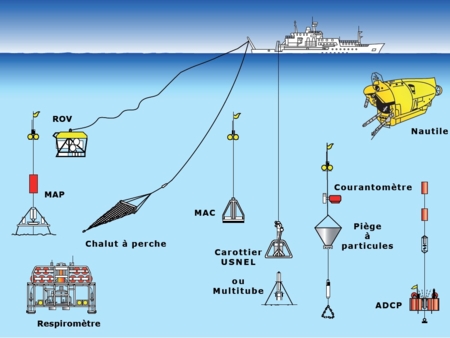Diversity study of bacterial epibionts associated to cephalothorax of hydrothermal shrimp Rimicaris exoculata
Deprived of kight, the deep-sea hydrothermal vents are extreme ecosystems sustained by bacterial chemosynthesis. These environments are colonized by animal species living in close relationships with these chemoautotrophic micro-organisms, eating them or establishing long term interactions with them, trophic or not.
The shrimp Rimicaris exoculata is an endemic hydrothermal species of the Midle-Atlantic Ridge (MAR) sites. It is the dominant species on several hydrothermal vent sites. This crustacean has an enlarged gill chamber, harboring a dense ectrosynbiotic community. Until now, their acquisition and their metabolic pathways were not fully understood. The presence of a microbial community in the digestive tract has also been described. First, this study focused on the analyses of the possible differences in the epibiotic community among the gill chamber epibiotic community along R. exoculata life cycle. Then, we have looked for the bacterial metabolisms suspeceted to occur among this community.
This work confirmed that the epibiotic community of the R. exoculata cephalothorax is dominated by two phylotypes: Epsilonproteobacteria and Gammaproteobacteria. There are always present and active. They are eliminated and then recolonised the cephalothorax after each moult. In addition, they are detected in the environment (horizontal transmission). However, the relative proportion of these phylotypes seemed to vary along the host life cycle (eggs/larvae versus juvenile/adult). According to the geochemical conditions of various hydrothermal sites, research on the metabolic pathways of these epibionts has confirmed recent hypothesis. The energetic pathways such as the methanotrophy, the sulfur-oxidation/reduction and the hydrogenotrophy were detected from the cephalothorax epibionts as well as the autotrophic pathways (rTCA and Calvin cycles). Results also showed that the oxidation of the sulfur compounds seemed to be the major pathways with constant activity., whereas the oxidation of methane and hydrogen seemed to be threshold dependent and so linked ti the geochemical conditions of the host life environment. This study broadened our view on the relations between the cephalothorax epibionts and the hydrothermal shrimp Rimicaris exoculata.







